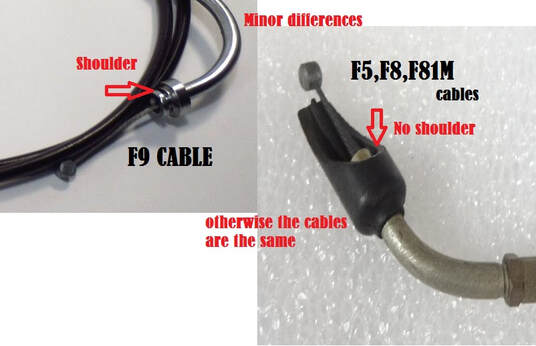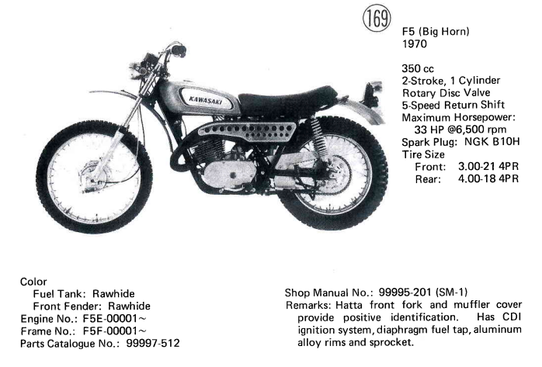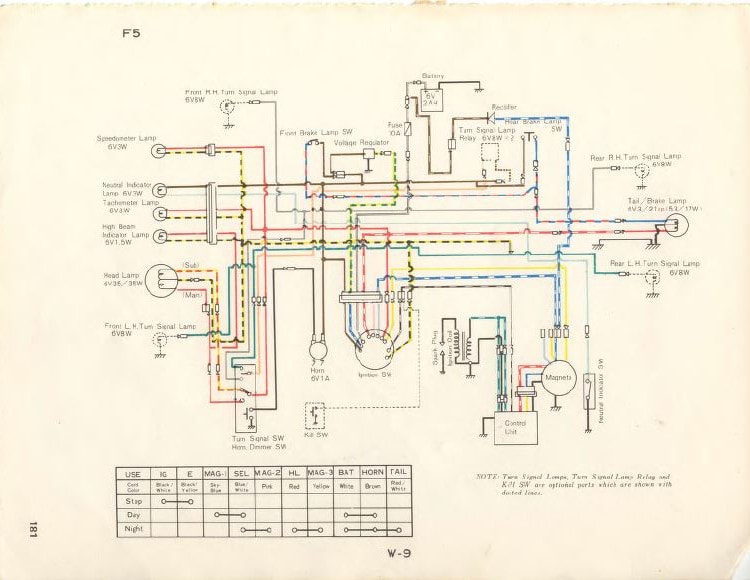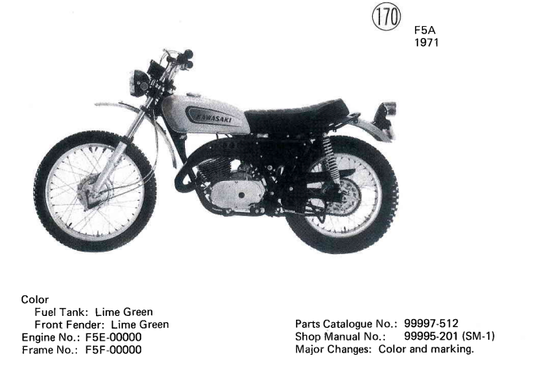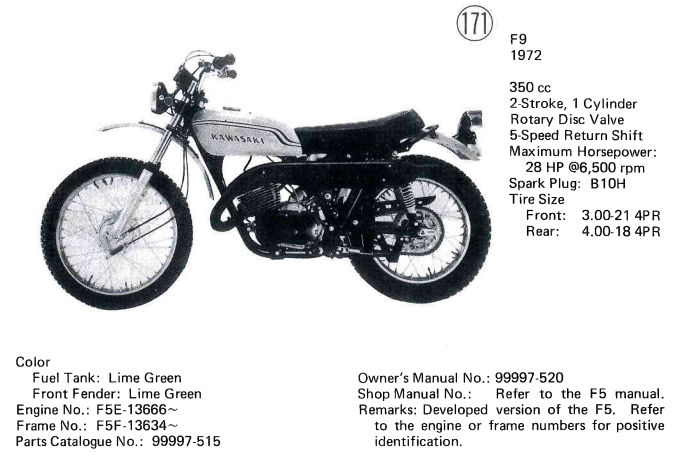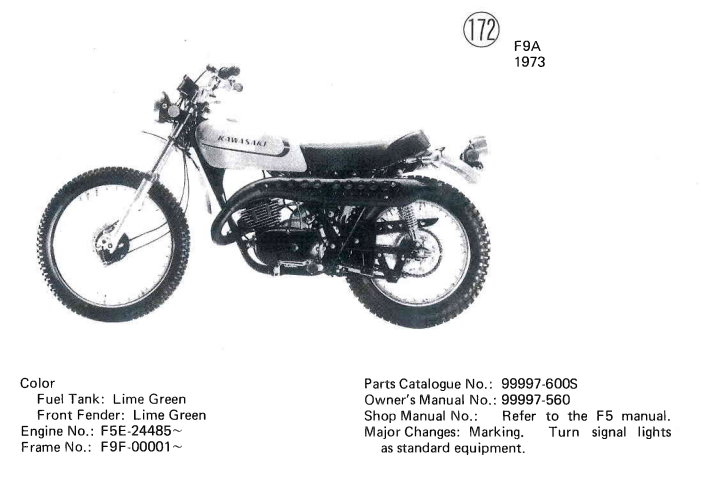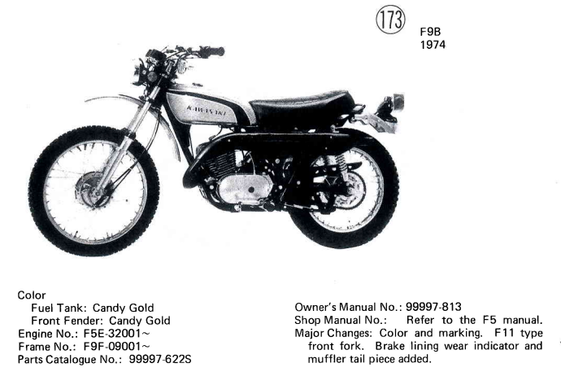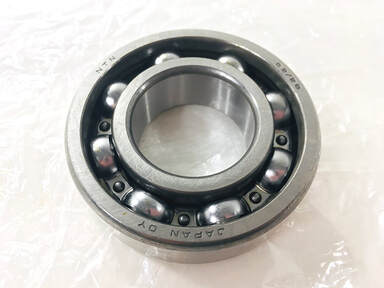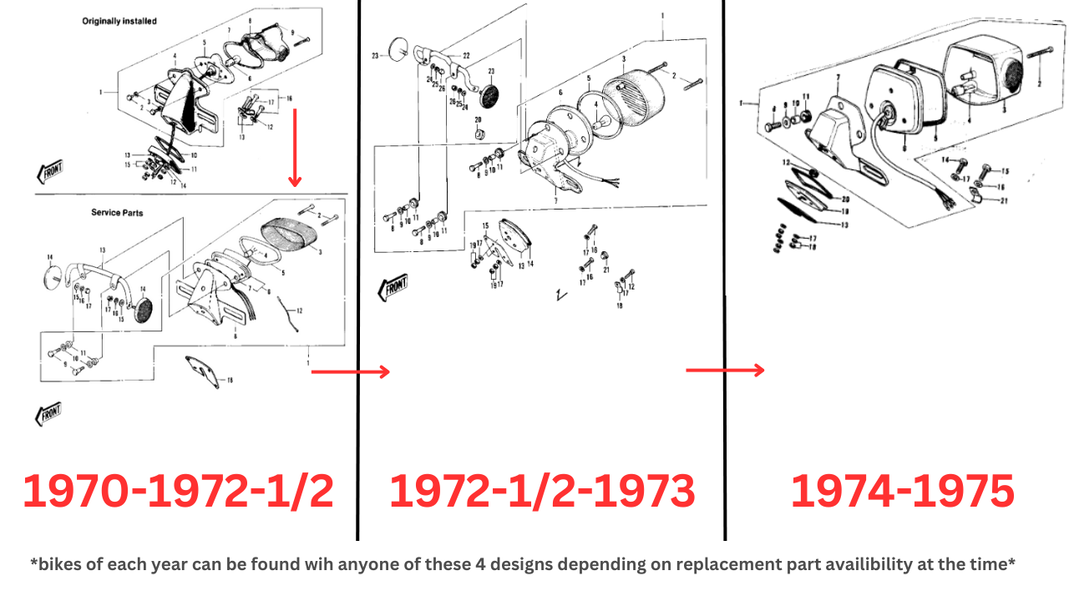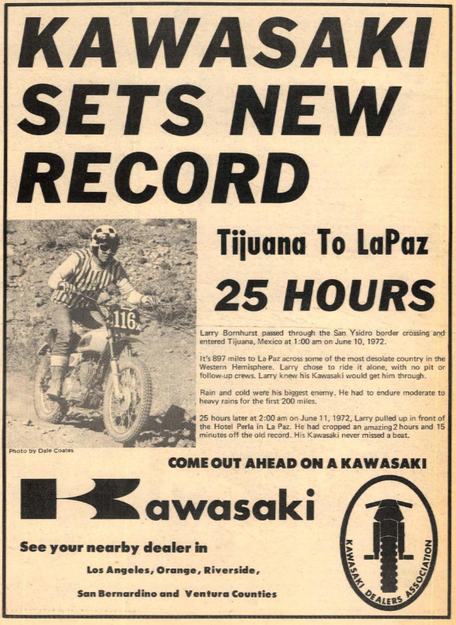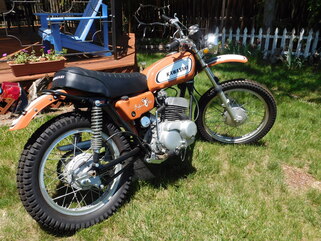 My Barn Fresh Restoration Kawasaki F5
My Barn Fresh Restoration Kawasaki F5
350 CC (Big Horn)
F5, F9
The Kawasaki Big Horn! Probably one of the most notorious of the rotary valve singles made by Kawasaki. Technically speaking only the F5 (1970) and F5A (1971) are Big Horn's. It was only those 2 years where they marketed the bike using "Big Horn" in marketing materials. The F5A would also have "350E" designated in marketing literature to denote "Enduro" just like the rest of the model lineup in 1971.
For 1970 Kawasaki offered the "Power Pak" or "Speed Kit" for the F5. It was a collection of parts and specifications to increase power. Later in 1971 this was dropped for the F9. However all parts are compatible with all years of F9's. The "Speed Kit" claimed to raise the horsepower from the advertised 33 to 45. Fun fact! The muffler/expansion chamber, rotary valve disc, in the kit is the same one that came stock on the F81M. This is also true for the carburetor cover and air filter cutout on the side. The "Power Pack" was similar to Yamaha's GYT Kit offered for the DT1 & RT1M/RT1MX.
The F9 shares a lot with the F5 but there are few differences in engine covers and a few internal parts. However most things interchange and as a whole the F9 is considered a more developed/refined version of the F5. Most refinements were in ways to make the engine more reliable and a more comfortable ride. Read here about the unique design for evacuating fuel/water from the carburetor chamber on the F5/F9, also known as the "drain pump".
Kawasaki Big Horn F5 & F9 Model Year Identification chart: *it is common for frame and engine numbers to mis-match
*73-75 frames begin using F9 prefix, Engine #'s continue to use F5E prefix
F5, F9
The Kawasaki Big Horn! Probably one of the most notorious of the rotary valve singles made by Kawasaki. Technically speaking only the F5 (1970) and F5A (1971) are Big Horn's. It was only those 2 years where they marketed the bike using "Big Horn" in marketing materials. The F5A would also have "350E" designated in marketing literature to denote "Enduro" just like the rest of the model lineup in 1971.
For 1970 Kawasaki offered the "Power Pak" or "Speed Kit" for the F5. It was a collection of parts and specifications to increase power. Later in 1971 this was dropped for the F9. However all parts are compatible with all years of F9's. The "Speed Kit" claimed to raise the horsepower from the advertised 33 to 45. Fun fact! The muffler/expansion chamber, rotary valve disc, in the kit is the same one that came stock on the F81M. This is also true for the carburetor cover and air filter cutout on the side. The "Power Pack" was similar to Yamaha's GYT Kit offered for the DT1 & RT1M/RT1MX.
The F9 shares a lot with the F5 but there are few differences in engine covers and a few internal parts. However most things interchange and as a whole the F9 is considered a more developed/refined version of the F5. Most refinements were in ways to make the engine more reliable and a more comfortable ride. Read here about the unique design for evacuating fuel/water from the carburetor chamber on the F5/F9, also known as the "drain pump".
Kawasaki Big Horn F5 & F9 Model Year Identification chart: *it is common for frame and engine numbers to mis-match
*73-75 frames begin using F9 prefix, Engine #'s continue to use F5E prefix
|
2 stroke Oiling System: Injecto-Lube (can NOT disable for premix use, lubricates right side crank bearing & big end rod bearing)
Transmission oil: SAE 10W30 or ATF Ignition: CDI F5 Carburetor Settings Type- VM32SC (32mm) Main Jet - 132.5 (optional 127.5) "R" (round head) Needle Jet - 0-8 Jet Needle - 5FL 11-2 (late F5 5FL 11-3 8/2) Pilot Jet - 35 Cutaway - 2.5 (late F5 1.0) Air screw - 1-1/4 turns out F9 Carburetor Settings Type- VM30SC (30mm) Main Jet - 120 "R" (round head) Needle Jet - 0-8 Jet Needle - 5EJ 13-3 (F9 A/B/C 5EJ 13-6/2) Pilot Jet - 30 Cutaway - 1.5 (F9 A/B/C 2.0) Air screw - 1-1/2 turns out The F5 & F9 throttle cable has some differences in where it terminates at the throttle housing as shown (see pic). Note: 1972 F9 uses the same cable as the F5/F8/F81M, revised for the F9 A/B/C model years.
|
The carburetor changed from the F5, later F5 & F9 as the models were refined over the years. There are two different styles.
The F5 used a large body VM32SC of which there are two variants, an early and late model. (see graphic) The F9 (all years) use a small body VM30SC. *some are marked F9-2 Kawasaki F5 & F9 ignition magneto and lighting testing and values. See this video for help.
F5 1970 (Big Horn)
*New model, largest rotary valve single Engine and frame number range Engine No. F5E00001- (ending) 07268 Frame No. F5F-00001- (ending) 07182 Features the HATTA forks with the adjustable axle position. CDI ignition (same as on the F7). "Big Horn 350" name on the oil tank. Features aluminum rims & rear sprocket. Optional Power Pack or "Speed Kit" offered for 1970 that raised base horsepower from 33 to 45. Carburetor cover, throttle cable boot and right side engine cover changed mid-year to improve sealing, included chrome trim ring and threaded holes on both covers to clamp the throttle cable boot. Early engines had a different kick start mechanism and lever as well as a smaller big end rod bearing size. A changed mid year with engine numbers after 07268 (a 1971 year change) had larger (more reliable) big end rod bearings. Newer crankshaft assemblies will fit earlier engines. |
|
F5A 1971
*Stylistic changes, minor updates Engine No. F5E07269- (ending) 13665 Frame No. F5F07183- (ending) 13633 "350" now displayed on the oil tank. Marketing materials denote this model as 350E Big Horn. Stylistic changes. Seat cover changed. Headlight bucket is black, gauges changed to include anti-glare hoods. Chain guard painted black. Exhaust heat shield painted black. F9 1972
*model designation change, major updates, transition year Engine No. F5E13666- (ending) 24484 Frame No. F5F13634-(ending) 42370 *Frame numbers still retain the F5F prefix for this model year only. Model designation change. "Big Horn" removed from all marketing material and is just known as the "F9". Major refinements to the model. Rated horsepower down from 33 to 28, due largely to a smaller more compact carburetor, longer exhaust over the F5. Resulting power delivery is more smooth and linier. Steel rims & fenders replace the aluminum parts from the F5 to increase durability. Engine painted black for heat dissipation. Tail light design changed mid-year from the F5's triangular style to a triangular oval. Chain guard now features "speed holes". Lower chain guide now pressed steel. Carburetor cover design changed again, this time to a slimmer design to reduce overall engine width. F9A 1973
*Stylistic updates Engine No. F5E24485- (ending) 31999 Frame No. F9F00001- (ending) 08999 Frame numbers now start with F9F prefix. No major changes over the previous F9 model. Tail light design changed to an circular oval type. |
|
F9B 1974
*HATTA forks dropped, styling updates Engine No. F5E32001- (ending) 38599 Frame No. F9F09001- (ending) 15499 HATTA forks dropped, however the fork still have the adjustable pre-load adjustment, just no axle position adjustment. Remarks call these F11 type forks, as in similar to what comes on the F11 introduced in 1973. Different exhaust tail piece/spark arrestor (outlet changed). Tail light changed to a square type lens. Engine covers changed to a natural aluminum appearance. F9C 1975
*styling updates Engine No. F5E38600- (ending) 45451 Frame No. F9F15500- (ending) 22299 Styling updates. No major changes over previous year. Last year for the F9 and Kawasaki's 350cc single cyclinder engines. |
|
Crankshaft bearings for the Kawasaki F5 & F9 Big Horn can be elusive to find. The right side crank bearing for the F5 & F9 is a unique bearing with a machined shoulder (see picture). Below are the part numbers and where to buy it.
Right side bearing part# 92045-016 (buy it here) OR HERE (Amazon link) FAG bearing part# 6306-C3 Left side bearing part# 601B6305 which is much easier to find as it is more common. 92045-01 |
Below are some notable differences between model years for the Big Horn F5 and the F9
Model designation Key:
F5 = 1970
F5A = 1971
F9 = 1972-1975 (A,B,C for respective years 73-75)
The F5 (first year) was produced in relatively limited numbers at aprox. 7,000 units. Compared to Yamaha producing almost 3 times as many RT1's (360cc).
Early engines had a different kick start mechanism and lever as well as a smaller big end rod bearing size. A changed mid year with engine numbers after 07268 (mid 1970 year change) had larger (more reliable) big end rod bearings. Newer crankshaft assemblies will fit earlier engines. My early F5 bike has engine number 02300 and a build date of February 1970
F5 Control cables (clutch, rear brake, and tach) were silver. F5A/F9 (1971/1972-75) cables were black
F5 and F5A cylinders and heads are natural aluminum color, The F9 has black painted cylinders and heads
F5 ,F5A uses a 32mm (large body) carburetor, the F9 uses a 30mm (small body) carburetor. This accounts for the lower HP numbers for the F9, but made the bike a bit mellower which made for a better riding bike.
Carburetor cover and control cable boot are unique to the F5. F5A and later (F9) used a different cover and boot that improved sealing. This design changed twice.
F5 had Painted graphics. Later F5A and F9 used vinyl decals much like other manufacturers.
Handlebar is chrome and bend is unique to the F5 and F5A, The F9 used a different bend and came in black
.
Speedometer and tachometer are unique to the F5 with chrome trim rings. F5A gauges had rubber hoods to reduce glare, F9 the gauges changed slightly.
F5 chain guard is silver. The F5A is black, the F9 is black and of a different design.
F5, F5A and F9, F9A featured the Hatta forks, F9B and C changed to the more conventional forks similar to the F11 (1973 piston port 250cc) but still featured the adjustable pre-load, but did not have the adjustable axle position.
Foot pegs are rubber, round, spiked unique to the F5,and F5A. The F9 had a more conventional flat style rubber.
Muffler heat shield is chrome on the F5, black on the F5A both mufflers require optional bolt on spark arrestors. Without the spark arrestor the exhaust exits right before the rear shock. The F9 completely redesigned the muffler with a built in spark arrestor and bends around the rear shock exiting after the shock.
Alloy (aluminum) wheels were featured on the F5 and F5A The alloy wheels were soft (but light) and had a groove or lip that held mud when riding in muddy conditions. The F9 had chrome steel wheels that were heavier but more durable. They also had a more conventional flat profile that shed mud better. The F9 used heavier duty spokes as well.
Front brake drum design on the F5, F5A ,F9, F9A is lighter and compared to the F9B/C. It also uses a brake drum strut. The F9B/C front brake drum dimensionally larger and of a different design on the outside but uses the same brake shoes. It also features a brake wear indicator and a different brake arm actuator and the F5 brake drum strut was replaced with cast in slots that fit into tabs cast into the lower end of the forks. Thus lower fork tubes and/or front wheels are not interchangeable between the two groups of models.
Lightweight aluminum fenders on the F5 and F5A, The F9 changed to steel for durability. The physical designs of the fenders are identical though.
Rear tail lights are different on the F5 versus the F9. The F9 taillights are much heavier.
Model designation Key:
F5 = 1970
F5A = 1971
F9 = 1972-1975 (A,B,C for respective years 73-75)
The F5 (first year) was produced in relatively limited numbers at aprox. 7,000 units. Compared to Yamaha producing almost 3 times as many RT1's (360cc).
Early engines had a different kick start mechanism and lever as well as a smaller big end rod bearing size. A changed mid year with engine numbers after 07268 (mid 1970 year change) had larger (more reliable) big end rod bearings. Newer crankshaft assemblies will fit earlier engines. My early F5 bike has engine number 02300 and a build date of February 1970
F5 Control cables (clutch, rear brake, and tach) were silver. F5A/F9 (1971/1972-75) cables were black
F5 and F5A cylinders and heads are natural aluminum color, The F9 has black painted cylinders and heads
F5 ,F5A uses a 32mm (large body) carburetor, the F9 uses a 30mm (small body) carburetor. This accounts for the lower HP numbers for the F9, but made the bike a bit mellower which made for a better riding bike.
Carburetor cover and control cable boot are unique to the F5. F5A and later (F9) used a different cover and boot that improved sealing. This design changed twice.
F5 had Painted graphics. Later F5A and F9 used vinyl decals much like other manufacturers.
Handlebar is chrome and bend is unique to the F5 and F5A, The F9 used a different bend and came in black
.
Speedometer and tachometer are unique to the F5 with chrome trim rings. F5A gauges had rubber hoods to reduce glare, F9 the gauges changed slightly.
F5 chain guard is silver. The F5A is black, the F9 is black and of a different design.
F5, F5A and F9, F9A featured the Hatta forks, F9B and C changed to the more conventional forks similar to the F11 (1973 piston port 250cc) but still featured the adjustable pre-load, but did not have the adjustable axle position.
Foot pegs are rubber, round, spiked unique to the F5,and F5A. The F9 had a more conventional flat style rubber.
Muffler heat shield is chrome on the F5, black on the F5A both mufflers require optional bolt on spark arrestors. Without the spark arrestor the exhaust exits right before the rear shock. The F9 completely redesigned the muffler with a built in spark arrestor and bends around the rear shock exiting after the shock.
Alloy (aluminum) wheels were featured on the F5 and F5A The alloy wheels were soft (but light) and had a groove or lip that held mud when riding in muddy conditions. The F9 had chrome steel wheels that were heavier but more durable. They also had a more conventional flat profile that shed mud better. The F9 used heavier duty spokes as well.
Front brake drum design on the F5, F5A ,F9, F9A is lighter and compared to the F9B/C. It also uses a brake drum strut. The F9B/C front brake drum dimensionally larger and of a different design on the outside but uses the same brake shoes. It also features a brake wear indicator and a different brake arm actuator and the F5 brake drum strut was replaced with cast in slots that fit into tabs cast into the lower end of the forks. Thus lower fork tubes and/or front wheels are not interchangeable between the two groups of models.
Lightweight aluminum fenders on the F5 and F5A, The F9 changed to steel for durability. The physical designs of the fenders are identical though.
Rear tail lights are different on the F5 versus the F9. The F9 taillights are much heavier.

